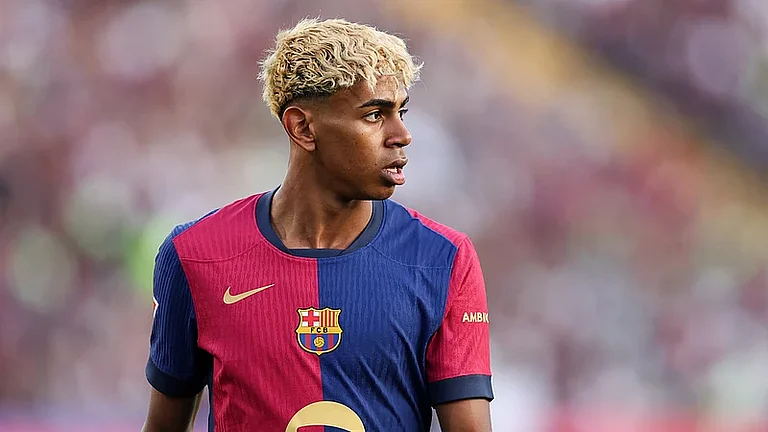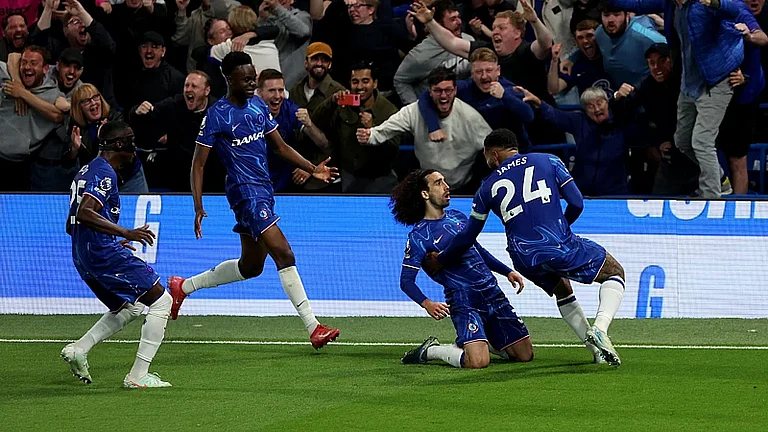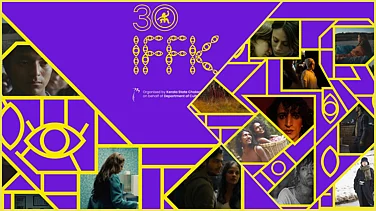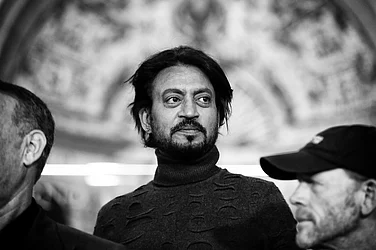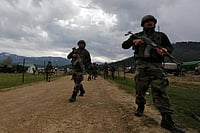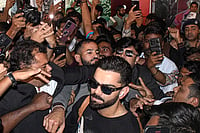"I wanted the audience to know the edge and slice its hand on it.... People are going to be dead silent or laughing their asses off, or both, when they see it." - Tarsem, year 2000s hottest Hollywood director, on his film The Cell
Rough cut of biodata: Born Tarsem Dhandwar Singh, 1962, Delhi; education: Modern School and St Stephens College, Delhi; Harvard Business School (dropped out); Art Centre, Pasadena, US; awards won for advertising filmmaking: Directors Guild of America Award for best commercial director of 1996, Clio and Cannes Gold Lion 1998, many mtv video music awards; seminal work: music video for R.E.Ms Losing My Religion, 1991, which brought the influence of Russian filmmaker Andrei Tarkovsky and Italian painter Caravaggio to mtv, Deep Forests Sweet Lullaby (1993), filmed on several continents in one month, commercials for Smirnoff, Coke, Nike, Reebok, Miller Lite etc etc etc. Favourite pastime: dreaming.
It shows. Dreamscapes, bizarre and unearthly images overcrowd his commercials and music videos. The sand dunes of the Thar desert in Jaisalmer, Rajasthan, against a bright red horizon haunted by Nusrat Fateh Ali Khans muezzin voice in a Coke film, an alternate universe inside a Smirnoff bottle at a hip party where the air is heavy with the background track of The Shining, a ballet of Reebok-clad youths dodging glass pieces falling from the sky in a slow rain, the worlds top soccer stars play against demons among the ruins of the Coliseum at Rome, a sheep bleeds to death on blue tiles to the thrum of Indian classical music: whatever he creates, wherever he is, Tarsems area of operation is the deeper recesses of the mind, probing, digging, delving to find pictures that confuse, stun, disturb, enthrall.
So too with The Cell, a sort of The Silence of the Lambs on lsd, starring Jennifer Lopez, Vince Vaughn and Vincent DOnofrio, that hit US theatres on August 18. While the New Line Cinema-produced movie grossed a cool $25 million in its first week and is expected to make another $100 million worldwide, critics and audiences are still trying to make up their minds about it. Is it sick? Or is it high art, Goya with digital technology? Lopez hesitated before signing the film because of its gory content but finally agreed after the contract stipulated that she would get 37 costume changes. "When I had my first meeting with Tarsem and he started showing me these pictures and stuff, I was so sick. I remember calling my manager and saying, "I cant do this," Lopez said in an interview on nbc. Before the release, she told the London Express: "We are going to get a lot of stick for this...there were days when Id think, are we going to get away with this?" "People are going to vomit," said DOnofrio. Admitted Lopez: "Its very extreme."
So? "My films are brushes with extremes. People either love them or hate them. Theres no middle line. Those who tread the middle line die fast," Tarsem explains over the phone from London, just back from the Venice Film Festival where a new bunch of people scratched their heads over The Cell (how does-should one react to a brilliantly photographed scene of a murderer playing his victims intestines like a harp?). "A visual medium needs to be treated for its visuals. Nothing else." Well, critics are definitely divided on that question. "The Cell is eye candy alright, but it lacks any nutritional value," sneers People magazine. But Stephen Farber writes in the Los Angeles Times: "Like it or not, it is possible to be aesthetically stimulated by a movie whose subject matter is repellent. "
This is The Cell. Uber-sicko DOnofrio abducts women and videotapes them slowly drowning to death in an automated plexiglass death chamber in the Mojave desert. An fbi raid goes haywire, hes wounded and goes into a coma. Trouble is: only he knows where his latest would-be victim is trapped; the fbi has 40 hours to find her. Enter Lopez, psychologist who uses an experimental technology to enter the killers subconscious and track the death chamber. Tarsem inside a twisted mind-phantasmagoric sequences of flowing red and saffron robes, moody silhouettes, religious icons and S&M symbolism, convoluted subterranean chambers and the stomach-churning boundaries of weirdspace is what Farber has called "one of the most hypnotic visual odysseys of recent years". And this right when sex and violence in films has erupted centrestage in the US Presidential elections. In the US, the film has earned an R rating for "bizarre, violent and sexual images, nudity and language".
Says Tarsem: "My sensibilities help me to dream and develop original ideas." Hes referring to his advertising work. He makes his credo clear: "I dont work on a clients storyboard. I need briefs, just two-liners and then its my idea and my storyboard. Either the client takes it or leaves it." And how does he contrast feature filmmaking with commercials? You can almost hear the shrug over the phone. Its the difference between a 100-m dash and a marathon in the Olympics. Both are about running but separate events. Nothing more, nothing less. "Is there something like the Hollywood system? I dont know. Its just the same process for a filmmaker though raising funds is kind of much more difficult for a feature film."
He talks about dreams and he talks in the same breath about reality. He mentions the mtv interstitial of the sheep bleeding to death, with the tag "Food for Thought" that unsettled and shocked viewers: "Thats life. You do not want to see what you eat at home. But then you remember it lifelong. I always love to romanticise with the subject and pick up a hard, realistic picture." And he talks of restlessness. He refuses to do anything more than once, which he attributes to his nomadic childhood. He travelled with his parents through Iran and the Himalayas when he was young. "I feel like a gypsy," he told an interviewer last year. "Any place I am, everybody asks me where home is; its always, Not where I am now. I feel kind of restless. Wherever I am I think my homes in the other place. And I go there and I feel, No, I want to be in the other place. And I feel like that about my work, which is I look at my work and I say, Wow, thats cool, but it doesnt look like me."
Will he work in India, make ads? "Sounds difficult because Indian agencies - or rather the companies - do not want to spend money to make their brand acquire a global character. They cant afford me and the crew with such ridiculously low budgets. And its extremely difficult to make a commercial exclusively for a domestic market for a global brand. Somehow, the western ethos does not work then and the pressure keeps building up because the global guys want a tinge of something the world associates with the country. So you put in the Taj," he laughs. He will, however, be back in India this fall to shoot two commercials for Campari and hsbc because the brief necessitates an oriental location.
So what next? It could be a personal film for which the detailed storyboards already worked out, and under wraps for obvious reasons. Another one could be on the life of car designer Enzo Ferrari. Directors he admires? Unsurprisingly, mysterious auteur David Lynch, but also Francis Ford Coppola, Martin Scorcese and David Mamet. "I like the Lynchian surrealism, which is dream logic as opposed to visual, beautiful images. I fall somewhere in between something as visual as Dali and something as brilliant for the mind as Lynch." It shows. To the confoundment of critics and the delight of his financiers.









